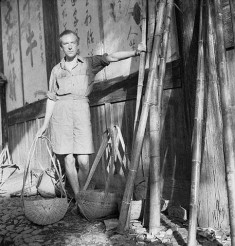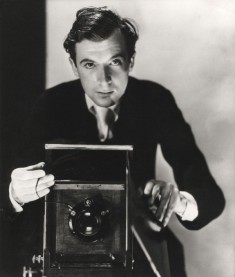| Cecil Beaton | |
|---|---|
 |
|
| Photographer | |
| Born | Jan. 4, 1904 Hampstead, London, England |
| Died | Jan. 18, 1980 (at age 76) Reddish House, Broad Chalke, Wiltshire, England |
| Nationality | English |
Sir Cecil Beaton was a popular English fashion, portrait, and war photographer, painter, diarist, interior designer and costume designer. In 1970, he was added to the International Best Dressed List Hall of Fame.
Early Life
Cecil was born on January 14, 1904. He was the son of a prosperous timber merchant. He was educated at Heath Mount School and St. Cyprian’s School where his artistic talent was discovered. When he was growing up, his nanny had a camera – a Kodak 3A camera – which was the very model renowned for being the ideal equipment on which to learn.
His nanny started teaching him the general basics of photography and film development. Beaton often got his mother and siblings to sit for him. When he became proficient, he sent the photos to various London society magazines.
Cecil attended Harrow and then moved to St. John’s College in Cambridge. Here, he studied history, art, and architecture. He also continued his photography and through his contacts, he managed to get a portrait depicting the Duchess of Malfi published in Vogue. In 1925, he left college with his degree. At first, he tried to work in an office but this turned to be very frustrating since he did not enjoy the work. Before long, he left for New York and slowly built his reputation as a photographer there.
Early Career in Photography
Cecil Beaton designed costumes for charity matinees and he learned the professional craft of photography at a studio. This went on until Vogue took him regularly in 1927. After this, he set up his own studio. Throughout his career, he used both large format cameras and smaller Rolleiflex cameras. Cecil focused on staging a compelling model or scene and actually looked for the perfect shutter-release moment.
Cecil is best known for his fashion photographs and society portraits. He worked for Vogue and Vanity Fair and even photographed celebrities in Hollywood. In 1938, he returned to England where he worked in the Ministry of Information. He became one of Britain’s leading photographers. He also photographed the Royal Family for official publication.
Stage and Film Design
After the end of the war, Cecil Beaton tackled Broadway stage, designing sets, costumes and lighting for Lady Windermere’s Fan. He is also known for the stage costumes for My Fair Lady in 1956, Gigi in 1958, The Grass Harp in 1952, The Chalk Garden in 1955, Saratoga in 1959, Tenderloin in 1960 and Coco in 1969.
Diaries and Personal Life
 Cecil Beaton was a published and well-known diarist. During his lifetime, six volumes of his diaries were published between the years 1922 and 1974. Over the past few years, other unexpurgated diaries have been published.
Cecil Beaton was a published and well-known diarist. During his lifetime, six volumes of his diaries were published between the years 1922 and 1974. Over the past few years, other unexpurgated diaries have been published.
In 1972, Cecil Beaton was made a Knight Bachelor in New Year Honors. Two years later, he suffered a stroke that left him permanently paralyzed on the right side of the body. Although he learned to use his left hand, he became very frustrated by the limitations the stroke had put upon his work. By the end of the 1970s, Cecil’s health deteriorated. In January of 1980, he passed away at the age of 76.